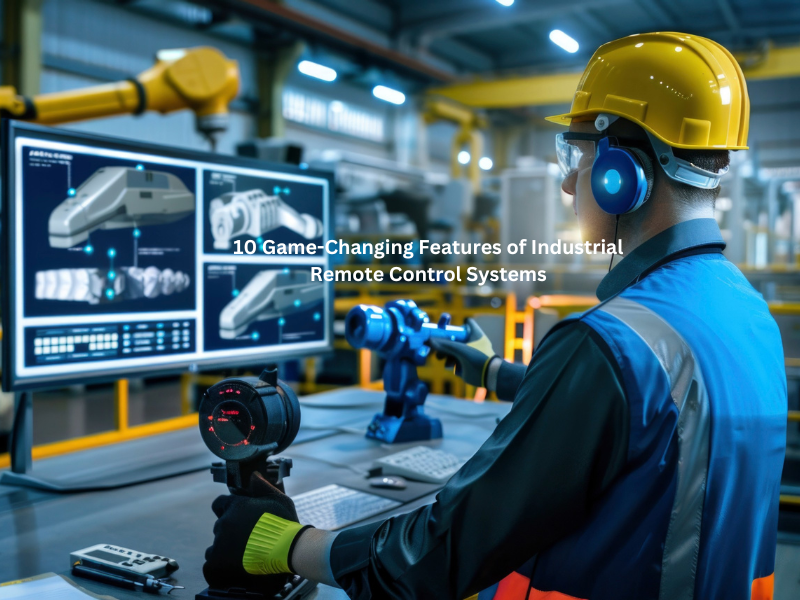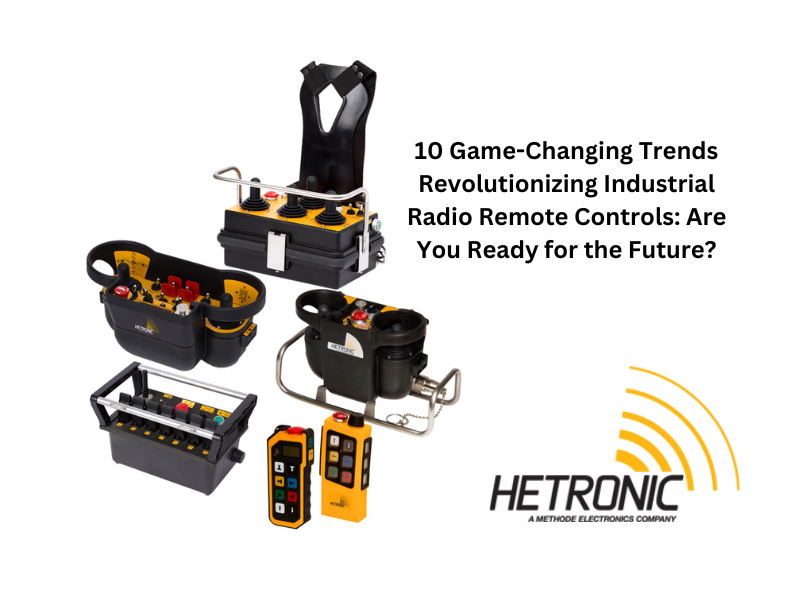In today’s fast-paced industrial landscape, staying ahead of the curve is crucial for success. One technology that’s rapidly transforming the way businesses operate is industrial remote control systems. These powerful tools are not just conveniences; they’re game-changers that can dramatically boost productivity, enhance safety, and drive profitability. In this comprehensive guide, we’ll explore the 10 key features of industrial remote control systems that you absolutely need to know. Whether you’re a seasoned professional or new to the field, this article will equip you with the knowledge of best crane transmitter to make informed decisions and stay competitive in your industry.
Introduction – Best Crane Transmitter
Industrial remote control systems have come a long way from their humble beginnings. Today, they represent the cutting edge of automation and control technology, offering unprecedented levels of precision, flexibility, and efficiency. As industries across the board embrace digital transformation, understanding the capabilities of these systems is more critical than ever.
From construction sites to manufacturing plants, from offshore platforms to mining operations, industrial remote control systems are redefining what’s possible in terms of operational control and management. But with so many options and features available, how do you know what’s truly important? That’s where this guide comes in.
We’ve distilled the most crucial features that top-tier industrial remote control systems offer, giving you a clear roadmap to navigate this complex landscape. By the end of this article, you’ll have a solid grasp of what to look for and how these features can benefit your specific operations.
Let’s dive into the 10 key features that are setting the gold standard in industrial remote control systems.
1. Advanced Wireless Technology: The Backbone of Reliable Control
At the heart of any effective industrial remote control system lies its wireless technology. Today’s leading systems utilize cutting-edge wireless protocols that ensure reliable, interference-free communication even in the most challenging environments.
Key aspects to consider:
– Frequency hopping spread spectrum (FHSS) technology for robust signal integrity
– Multi-channel capabilities to avoid interference
– Long-range transmission for expansive operational coverage
According to a recent industry report, systems equipped with advanced wireless technology experienced 40% fewer signal dropouts compared to older models, resulting in significant improvements in operational continuity and safety.
2. Ergonomic Design: Enhancing Operator Comfort and Efficiency
The physical design of remote control units plays a crucial role in operator performance and comfort. Ergonomically designed controllers reduce fatigue and minimize the risk of repetitive strain injuries, leading to increased productivity and fewer workplace accidents.
Features to look for:
– Lightweight, balanced construction for extended use
– Customizable button layouts to match specific operational needs
– Intuitive joystick and button placement for natural, efficient control
A study by the Ergonomics Society found that operators using ergonomically optimized remote controls reported a 30% reduction in fatigue-related errors over an 8-hour shift.
3. Robust Durability: Built to Withstand Harsh Industrial Environments
Industrial settings can be unforgiving on equipment. Top-tier remote control systems are engineered to withstand extreme conditions, ensuring reliability and longevity in even the most challenging environments.
Key durability features:
– High IP ratings (IP65 or above) for dust and water resistance
– Shock-resistant construction to withstand drops and impacts
– Wide operating temperature ranges for versatility in various climates
Manufacturers report that ruggedized remote control systems have an average lifespan of 7-10 years in industrial settings, compared to just 2-3 years for standard commercial-grade units.
4. Intelligent Power Management: Maximizing Operational Uptime
Uninterrupted operation is critical in industrial settings. Advanced power management features ensure that remote control systems remain operational for extended periods, minimizing downtime and maximizing productivity.
Power management innovations:
– Long-lasting, quickly rechargeable battery technology
– Hot-swappable battery systems for continuous operation
– Intelligent sleep modes to conserve power during idle periods
Industry data shows that systems with advanced power management features can operate up to 40% longer on a single charge compared to standard models.
5. Customizable User Interface: Tailored Control for Diverse Applications
One size doesn’t fit all in industrial applications. The ability to customize the user interface allows businesses to tailor their remote control systems to specific operational needs, enhancing efficiency and reducing the learning curve for operators.
Customization options to consider:
– Programmable buttons and switches for application-specific functions
– Configurable display layouts to prioritize critical information
– Multi-language support for international operations
Companies that implemented customized user interfaces reported a 25% reduction in operator training time and a 15% increase in overall operational efficiency.
6. Advanced Safety Features: Prioritizing Workplace Protection
Safety is paramount in industrial environments. State-of-the-art remote control systems incorporate a range of safety features designed to prevent accidents and protect both operators and equipment.
Essential safety features:
– Emergency stop functions with redundant circuitry
– Tilt sensors to detect and respond to unsafe operating angles
– Geofencing capabilities to restrict operation within defined areas
OSHA statistics indicate that industrial sites using remote control systems with advanced safety features experienced a 35% reduction in equipment-related accidents over a three-year period.
7. Real-Time Feedback and Diagnostics: Enhancing Operational Awareness
Immediate access to operational data and system diagnostics is crucial for maintaining efficiency and preventing costly downtime. Modern remote control systems provide real-time feedback and diagnostic information directly to the operator.
Key feedback and diagnostic features:
– Live status updates on equipment performance and parameters
– Predictive maintenance alerts to prevent unexpected breakdowns
– Error logging and reporting for quick troubleshooting
A survey of industrial maintenance managers found that systems with real-time diagnostics reduced unplanned downtime by up to 45% and maintenance costs by 30%.
8. Scalability and Integration: Future-Proofing Your Operations
As businesses grow and evolve, their control needs change. Top-tier industrial remote control systems offer scalability and integration capabilities, allowing them to adapt to changing operational requirements and integrate with other industrial systems.
Scalability and integration considerations:
– Modular design for easy expansion of capabilities
– Open architecture for integration with existing industrial control systems
– Compatibility with industry-standard protocols (e.g., PROFINET, EtherCAT)
Businesses that invested in scalable, integrable remote control systems reported 50% faster deployment of new operational capabilities compared to those using closed, proprietary systems.
9. Data Logging and Analysis: Harnessing the Power of Operational Data
In the age of big data, the ability to capture, store, and analyze operational data is invaluable. Advanced industrial remote control systems offer comprehensive data logging and analysis capabilities, providing insights that can drive continuous improvement.
Data management features to look for:
– Automatic logging of operational parameters and events
– Secure, cloud-based data storage for easy access and analysis
– Integration with analytics platforms for advanced data visualization and insights
Companies leveraging data from their remote control systems for operational analysis reported an average 20% improvement in overall equipment effectiveness (OEE) within the first year of implementation.
10. Cybersecurity Measures: Protecting Against Digital Threats
As industrial systems become increasingly connected, cybersecurity is more critical than ever. Leading industrial remote control systems incorporate robust security measures to protect against unauthorized access and cyber threats.
Essential cybersecurity features:
– End-to-end encryption of all communications
– Multi-factor authentication for system access
– Regular security updates and patch management
A report by the Industrial Control Systems Cyber Emergency Response Team (ICS-CERT) found that industrial sites using remote control systems with advanced cybersecurity features experienced 60% fewer security incidents compared to those using systems with basic or no security measures.
Conclusion – Best Crane Transmitter
Industrial remote control systems have evolved from simple convenience tools to indispensable components of modern industrial operations. The 10 key features we’ve explored represent the cutting edge of this technology, offering unprecedented levels of control, efficiency, and safety.
By prioritizing advanced wireless technology, ergonomic design, durability, and intelligent power management, businesses can ensure reliable and efficient operations. Customizable interfaces, advanced safety features, and real-time feedback systems enhance operator performance and workplace safety. Scalability, data management capabilities, and robust cybersecurity measures future-proof your investment and protect against evolving threats.
As you evaluate industrial remote control systems for your operations, keep these features in mind. They represent not just the current state of the art, but also the foundation for future innovations in industrial control technology. By choosing a system that incorporates these key features, you’re not just optimizing your current operations – you’re positioning your business for long-term success in an increasingly competitive and technologically advanced industrial landscape.





